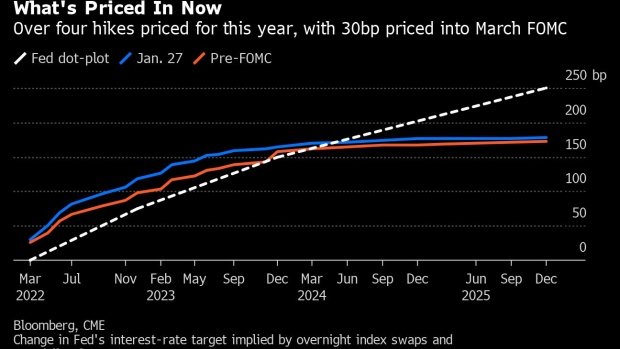Jan 29, 2022
Threat of 50 Basis Points Is New World for 21st Century Traders
, Bloomberg News

(Bloomberg) -- Jerome Powell has spoken, and his pronouncements on rate policy have left investors as confused about what the Federal Reserve is planning as they have been in more than two decades. The result: a severe uptick in market volatility.
With three of the biggest intraday swings in a decade just in the past week, uneasiness in stocks is approaching levels last seen in March 2020, when the coronavirus outbreak began. The Cboe Volatility Index, an options-derived measure of equity turbulence, spent most of the last five days above 30, nearly twice its level at the start of the year.
Smack in the middle of the storm is Fed Chair Powell, who on Wednesday affirmed plans to begin withdrawing economic stimulus in March and -- worse, for the nerves of equity bulls -- turned down multiple opportunities to confirm the hiking cycle would be gradual.
The repricing was swift: the bond market is now bracing for five hikes in 2022, including an outside chance of a rare 50 basis-point move in March -- something not seen since 2000. While such a dramatic move is firmly an outlier view -- roughly 30 basis points of tightening is priced in, implying roughly one-in-five odds of a half-point hike -- it’s a possibility traders must consider. And that’s in turn roiling the stock market.
“Not only did he leave a 50 basis point increase on the table, but he also said they might be willing to hike rates at every meeting for a while,” Matt Maley, chief market strategist at Miller Tabak + Co., said of Powell. “Very few on Wall Street today remember how the market works when inflation is a problem.”
The S&P 500 rallied Friday to narrowly avoid a fourth straight week of losses, finishing the week 0.8% higher. Between a raft of big-tech earnings and the Fed’s meeting, the S&P 500 swung by an average of 3.4% per day in its most turbulent week since March 2020.
The bulk of the pain has been levied on richly valued tech stocks, which would theoretically be most vulnerable to an aggressive Fed hiking cycle. The Nasdaq 100 finished the week just 0.1% higher -- a tiny move that masks the most violent gyrations since the dot-com crash.
While investors have dealt with a tightening Fed before, it’s been a long time since they’ve had to confront one that’s been anything less than transparent in its intentions -- at least concerning the pace of increases. In 2015, then-Fed chair Janet Yellen said economic conditions were expected to “warrant only gradual increases” in rates. Back before the financial crisis broke out, Alan Greenspan’s template was to act “at a pace that is likely to be measured.”
Powell made no such “gradual” or “measured” pledge Wednesday. While he said the Fed is “of a mind” to hike in March, Powell repeatedly emphasized that there’s no set plan beyond that. The Fed chief also made clear that officials would be “humble” and “nimble” in their approach to adjusting policy.
To Bank of America analysts, that means that a 50 basis-point move to tame the hottest pace of inflation in nearly four decades can’t be ruled out.
“A humble & nimble Fed likely knows 50bps is appropriate,” analysts led by Mark Cabana wrote in a note Friday. “If the market prices 50bp in March, the Fed should follow.” While not a base case, “we see it as reasonable market risk/reward,” they wrote.
One source of solace: the Cboe’s index, known as Wall Street’s fear gauge, is pricing in more market uncertainty in the here-and-now than it is down the road -- a set-up known as inversion. Over the past week, its spot price has traded above the three-month futures contract, a departure from the norm.
Investors who might be facing their first unexpectedly aggressive Fed should be soothed by Powell’s confidence in the economy, said DataTrek Research co-founder Nicholas Colas. But that still leaves investors guessing the right interest rate to use to calculate share price values, he said.
“The only olive branch they offered to investors was the fact that the U.S. economy is running strong. That should translate into higher corporate profits in 2022 and support stock and corporate bond prices,” Colas wrote in a Thursday note. “What discount rate should the market use to capitalize those earnings? That is the question of the hour. And, perhaps, the year.”
©2022 Bloomberg L.P.